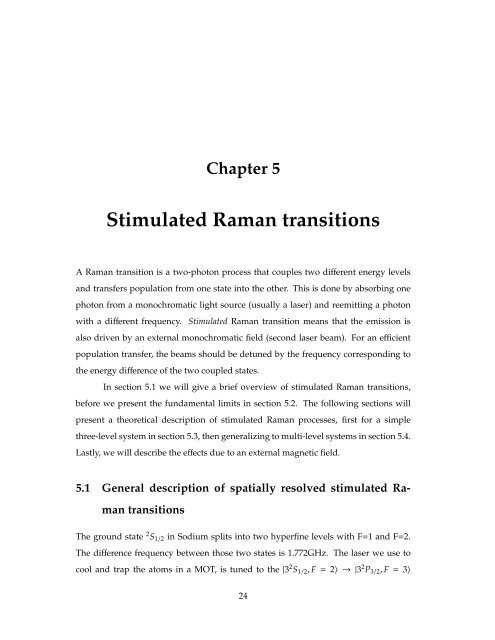Copyright by Kirsten Viering 2006 - Raizen Lab - The University of ...
Copyright by Kirsten Viering 2006 - Raizen Lab - The University of ...
Copyright by Kirsten Viering 2006 - Raizen Lab - The University of ...
Create successful ePaper yourself
Turn your PDF publications into a flip-book with our unique Google optimized e-Paper software.
Chapter 5<br />
Stimulated Raman transitions<br />
A Raman transition is a two-photon process that couples two different energy levels<br />
and transfers population from one state into the other. This is done <strong>by</strong> absorbing one<br />
photon from a monochromatic light source (usually a laser) and reemitting a photon<br />
with a different frequency. Stimulated Raman transition means that the emission is<br />
also driven <strong>by</strong> an external monochromatic field (second laser beam). For an efficient<br />
population transfer, the beams should be detuned <strong>by</strong> the frequency corresponding to<br />
the energy difference <strong>of</strong> the two coupled states.<br />
In section 5.1 we will give a brief overview <strong>of</strong> stimulated Raman transitions,<br />
before we present the fundamental limits in section 5.2. <strong>The</strong> following sections will<br />
present a theoretical description <strong>of</strong> stimulated Raman processes, first for a simple<br />
three-level system in section 5.3, then generalizing to multi-level systems in section 5.4.<br />
Lastly, we will describe the effects due to an external magnetic field.<br />
5.1 General description <strong>of</strong> spatially resolved stimulated Ra-<br />
man transitions<br />
<strong>The</strong> ground state 2 S1/2 in Sodium splits into two hyperfine levels with F=1 and F=2.<br />
<strong>The</strong> difference frequency between those two states is 1.772GHz. <strong>The</strong> laser we use to<br />
cool and trap the atoms in a MOT, is tuned to the |3 2 S1/2, F = 2〉 → |3 2 P3/2, F = 3〉<br />
24
















